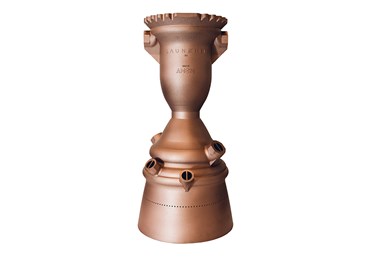AMCM Systems Open Possibilities for Demanding Metal Applications
The AMCM M 290 1 kW system is said to ensure that the finest structures, such as complex cooling channels, can be produced even in larger copper components.
Share
Read Next

The AMCM M 290 1 kW system can print 1 m high rocket engine combustion chambers (copper alloy).
Additive Manufacturing Customized Machines (AMCM), an EOS company, is customizing additive manufacturing (AM) systems to enable new applications in 3D metal printing not supported by standard AM systems. The customized AM solutions are based on proven EOS technology and processes, and built with varying degrees of customization, either almost completely new designs or as modified and enhanced EOS systems.
The AMCM M 290 1KW is an adaptation of the EOS M 290 with an increased laser power of 1kW. This opens further possibilities for demanding copper applications, among others. For applications such as inductors, heat exchangers or stators in the field of e-mobility, the combination of a large build area and a fine 80 µm spot enables the AMCM M 290 1 kW to ensure that the finest structures, such as complex cooling channels, can be produced even in larger copper components.
In these pure copper applications, the AMCM M 290 1 KW, in conjunction with the right process parameters, is said to achieve a 100% International Annealed Copper Standard (IACS) electrical conductivity to produce highly efficient components. By using the infrared fiber laser technology, customers are able to use all standard EOS processes in addition to those developed for the 1kW system. The system can also be equipped with two 1 kW lasers to further increase system throughput.
The EOS M 290 has been adapted with the smallest possible spot size and maximum component size to enable fine detail applications. With the AMCM M 290 upgrade, wall structures of 100 µm can be produced. The combination of finest spot sizes and the possible part size of 135 × 220 mm enables the sophisticated design of anti-scatter grids to be manufactured in a novel and optimized way, the company says. With a special software optimized for refractive tungsten, grids of reproducible high quality can be built without issue.
Related Content
-
3D Printing with Plastic Pellets – What You Need to Know
A few 3D printers today are capable of working directly with resin pellets for feedstock. That brings extreme flexibility in material options, but also requires greater knowledge of how to best process any given resin. Here’s how FGF machine maker JuggerBot 3D addresses both the printing technology and the process know-how.
-
New Electric Dirt Bike Is Designed for Molding, but Produced Through 3D Printing (Includes Video)
Cobra Moto’s new all-electric youth motocross bike could not wait for mold tooling. Parts have been designed so they can be molded eventually, but to get the bike to market, the production method now is additive manufacturing.
-
How to Build 10,000+ Shot Molds in Hours
Rapid tooling isn’t so rapid when it takes days to 3D print a metal mold, and then you still must machine it to reach the necessary tolerances. With Nexa3D’s polymer process you can print a mold in hours that is prototype or production ready and can last for more than 10,000 shots.







.png;maxWidth=300;quality=90)




